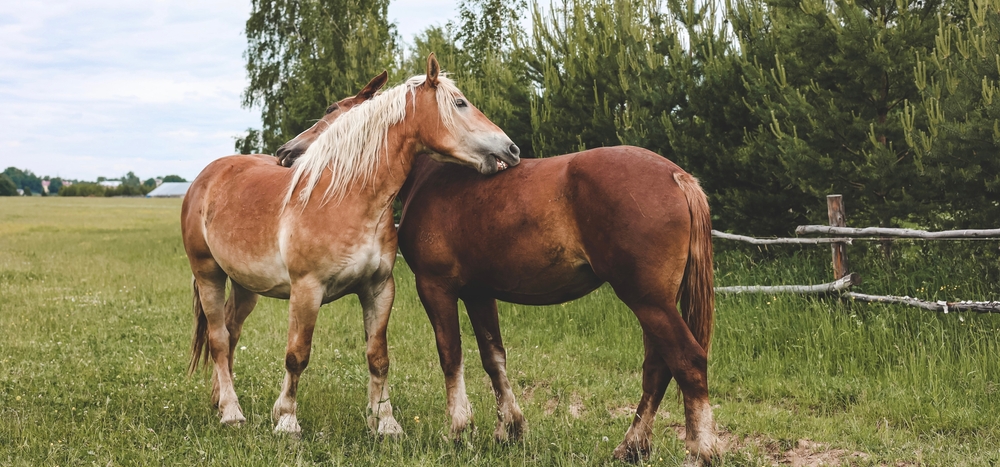Whinny’s Wisdoms

Hey, everybody! Whinny checking in this week to discuss one of the most common diseases the Doctor’s here see in horses. I often hear them refer to it as Cushing’s. However, being a proper mouse I’m going to call it by its actual name: PPID.
What is PPID?
PPID, or pituitary pars intermedia dysfunction, is a disease that occurs when the pituitary gland, a small pea-sized structure at the base of the brain, produces too much of a hormone called ACTH. ACTH stimulates the adrenal glands to produce cortisol, which is a hormone that helps the body respond to stress. At least that’s how Cushing’s works in dogs and humans, two other species commonly affected by a similar syndrome.
Horses have to be different and that’s why they get a special name for their version. You see, dogs and humans are affected in the anterior pituitary. Horses are affected in the intermediate, or pars intermedia, area of the pituitary. This area releases way more than just ACTH. It can release up to 5,000 different hormones. These hormones are largely responsible for maintaining the status quo of the body. They tell cells things like: it’s daytime, or nighttime, winter is coming, we should probably eat more, time to grow a lot of hoof, and on and on. All the things that make a body function day-to-day. The changes involved in PPID take time to occur. This means most, but not all, affected horses are over 15 years of age.
Symptoms
PPID can cause a variety of symptoms in horses, and the severity of the symptoms can vary depending on the stage of the disease. Some common symptoms include:
- Curly coat: The horse’s coat may become dull, dry, and curly. This is the most common symptom people think of with PPID horses, but I’m here to let you know it’s often one of the last ones horses develop! If this is the first sign you see, you’re probably late to the game.
- Weight loss/weight gain: A change in weight that doesn’t make sense, up or down, often goes with PPID
- Decreased performance: One of the first, very subtle signs, horses may show is decreased performance. That might show up as less power, speed, or endurance.
- Infections: Horses with PPID have a suppressed immune system. This makes them more susceptible to chronic infections of the skin and teeth. It also makes them more susceptible to internal parasites.
- Increased thirst and urination: Horses with PPID may drink more water and urinate more frequently.
- Laminitis: PPID can increase the risk of laminitis. This is the scariest symptom of PPID. Its onset is often insidious. Yearly foot radiographs can help spot this symptom early!

Diagnostics
If you suspect that your horse may have PPID, it’s important to consult with one of our veterinarians. They can perform a physical examination and may recommend blood tests to measure the level of ACTH in the horse’s bloodstream. In some cases, a test called a TRH stimulation test may also be performed. This test involves administering a hormone called TRH, which should cause the pituitary gland to release ACTH. If the horse’s ACTH levels increase significantly after the TRH stimulation test, it may be a sign of PPID.
Treatments
There is no cure for PPID, but the condition can be managed with appropriate treatment. The goal of treatment is to help regulate the pituitary gland. This can be achieved through a combination of medications, dietary changes, and regular veterinary care.
- Medications: There are several medications available to treat PPID, including pergolide and cyproheptadine. These medications can help to reduce the production of ACTH. Pergolid is a very picky medication that has to be manufactured and stored under very specific conditions! Be sure you are using a form that meets those requirements. In North America, only Prascend meets these conditions.
- Dietary changes: Horses with PPID may benefit from a diet that is low in carbohydrates and high in fiber. Many, but not all, horses with PPID also experience insulin resistance. If your horse has both, then a low starch diet will be necessary.
- Regular veterinary care: It’s important to monitor horses with PPID closely and to provide regular veterinary care. Regular check-ups looking for laminitis, those pesky infections, and fecal egg counts are very important, along with routine vaccinations.
Conclusion
PPID is a complex condition that can affect horses of all breeds. While there is no cure, it can be managed with appropriate treatment. If you suspect that your horse may have PPID, it’s important to consult with our veterinarians for diagnosis and treatment. By working with our veterinarians, you can help your horse live a long and healthy life.
Well, that’s all for now, folks! I hope you learned something new about PPID. I’ll be back soon with more adventures from the veterinary clinic. Until then, stay curious and keep exploring!
Until next week,
~Whinny
P.S. If you want to know more about PPID, or just about anything else related to horse health, you should listen to the podcast my humans produce! It’s called Straight from the Horse Doctor’s Mouth and you can listen to it right here on my website! Just click this link to go to the Podcast Page, scroll down through the episode list, and click play on whatever catches your eye. As a matter of fact, I’ll put a sampler right below here so you can check it out. Go ahead and click play on something, it won’t bite!
 Whinny’s Wisdoms is the official blog of Whinny the Clinic Mouse at Springhill Equine Veterinary Clinic in Newberry, Florida. If you liked this blog, please subscribe below, and share it with your friends on social media! For more information, please call us at (352) 472-1620, visit our website at SpringhillEquine.com, or follow us on Facebook!
Whinny’s Wisdoms is the official blog of Whinny the Clinic Mouse at Springhill Equine Veterinary Clinic in Newberry, Florida. If you liked this blog, please subscribe below, and share it with your friends on social media! For more information, please call us at (352) 472-1620, visit our website at SpringhillEquine.com, or follow us on Facebook!
[jetpack_subscription_form title="Subscribe to Whinny's Wisdoms"]

